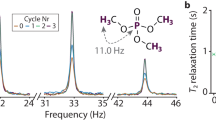Conclusions
1. The NMR signal width of blood protons is determined by symmetric broadening caused by dipoledipole interaction of blood plasma protons and asymmetric broadening caused by erythrocytes.
2. The signal broadening caused by erythrocytes is determined by deviation of the cell shape from spherical, and it increases linearly as the degree of blood oxygenation decreases.
3. The NMR signal width can be used for determining the degree of blood oxygenation, whereas the width to the resonance frequency shift ratio can provide information about erythrocyte shape.
Similar content being viewed by others
References
V. R. Arnol'd, Design and Computation of Systems with Static Magnets [in Russian], Moscow (1969).
L. A. Blyumenfel'd, Hemoglobin and Reversible Oxygen Uptake [in Russian], Moscow (1956).
A. I. Zhernovoi, L. M. Sharshina, G. L. Antokol'skii, et al., Available from VINITI, No. D15429-88 (1988).
A. I. Zhernovoi, L. M. Sharshina, and D. V. Aleksandrov, Med. Tekh., No. 3, 10–11 (1997).
B. I. Zbarskii and I. I. Ivanov, Biological Chemistry [in Russian], Moscow (1972).
C. Kittel, Phys. Rev.,73, No. 2, 155–161 (1948).
Author information
Authors and Affiliations
Rights and permissions
About this article
Cite this article
Zhernovoi, A.I., Sharshina, L.M. Effect of blood oxygenation on proton NMR signal shape. Biomed Eng 34, 1–4 (2000). https://doi.org/10.1007/BF02385217
Issue Date:
DOI: https://doi.org/10.1007/BF02385217




